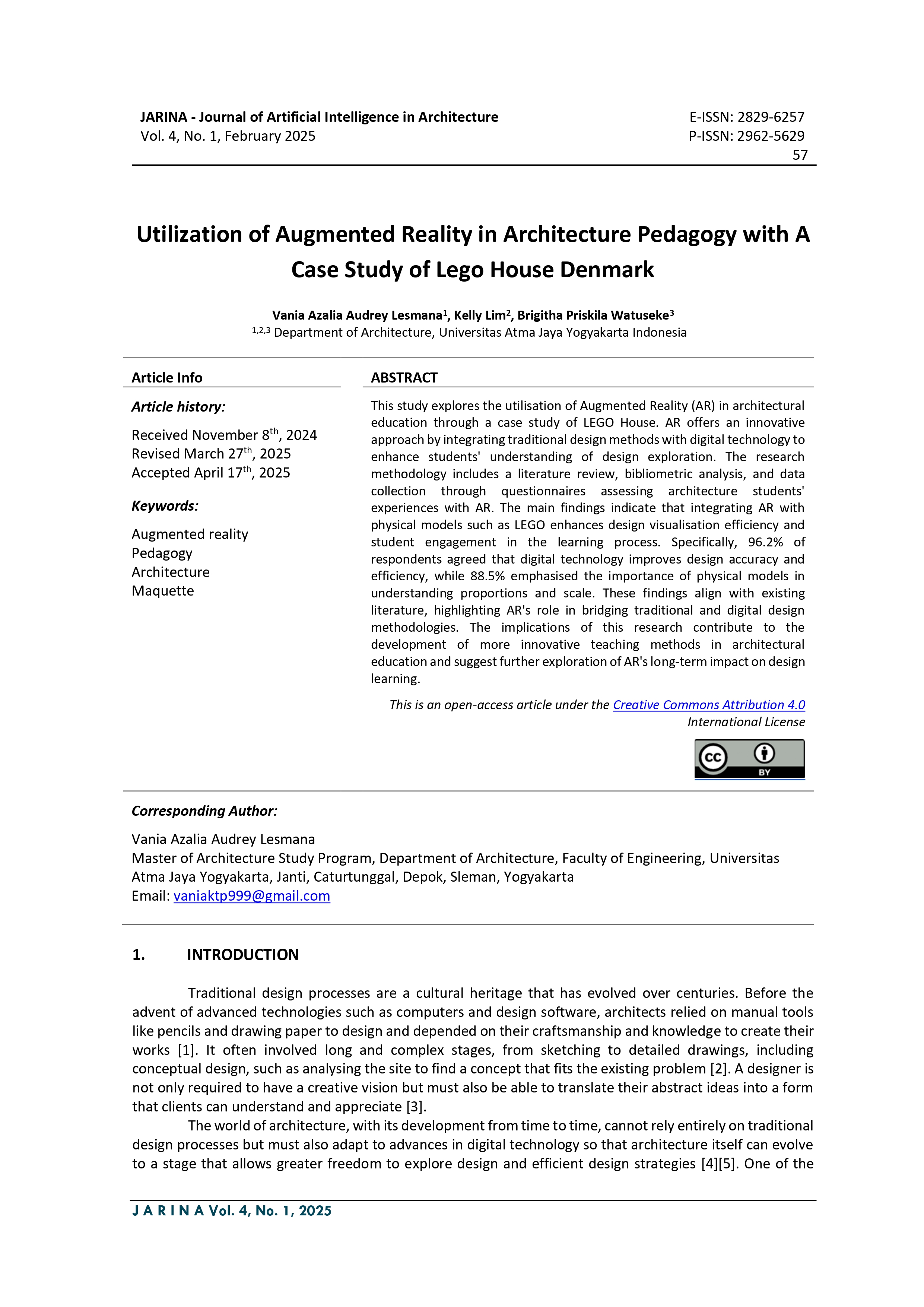Utilization of Augmented Reality in Architecture Pedagogy with A Case Study of Lego House Denmark
DOI:
https://doi.org/10.24002/jarina.v4i2.10152Keywords:
Augmented Reality, Pedagogy, Architecture, MaquetteAbstract
This study explores the utilisation of Augmented Reality (AR) in architectural education through a case study of LEGO House. AR offers an innovative approach by integrating traditional design methods with digital technology to enhance students' understanding of design exploration. The research methodology includes a literature review, bibliometric analysis, and data collection through questionnaires assessing architecture students' experiences with AR. The main findings indicate that integrating AR with physical models such as LEGO enhances design visualisation efficiency and student engagement in the learning process. Specifically, 96.2% of respondents agreed that digital technology improves design accuracy and efficiency, while 88.5% emphasised the importance of physical models in understanding proportions and scale. These findings align with existing literature, highlighting AR's role in bridging traditional and digital design methodologies. The implications of this research contribute to the development of more innovative teaching methods in architectural education and suggest further exploration of AR's long-term impact on design learning.
References
[1] V. Alekhya, S. Jose, S. Lakhanpal, I. Khan, S. Paul, and Q. Mohammad, “Integrating Augmented Reality in Architectural Design: A New Paradigm,” E3S Web Conf., vol. 505, 2024, doi: 10.1051/e3sconf/202450503009.
[2] W. Anthony, “The LEGO story,” Scand. Rev., 2018.
[3] F. G. Bili, D. L. Bili, and A. A. K. Kalumbang, “Pemanfaatan Permainan Lego Untuk Mengembangkan Kreativitas Anak Usia 5-6 Tahun TK ST . Mathilda Unika Weetebula,” J. Educ., vol. 06, no. 03, pp. 17154–17163, 2024.
[4] K. Cowan, “Multimodal technologies in LEGO house: A social semiotic perspective,” Multimodal Technol. Interact., vol. 2, no. 4, 2018, doi: 10.3390/mti2040070.
[5] S. P. Dash, “An exploratory study on design process in architecture: Perspective of creativity,” Creat. Stud., vol. 14, no. 2, pp. 346–361, 2021, doi: 10.3846/cs.2021.12989.
[6] G. Esmeraldo, C. S. Mendes, L. Fontes, and E. Lisboa, “Um Estudo Comparativo entre Simuladores Computacionais para Apoio à Disciplina de Arquitetura e Organização de Computadores,” pp. 434–443, 2019, doi: 10.5753/ctrle.2019.8915.
[7] D. J. Gerber and S. H. E. Lin, “Designing in complexity: Simulation, integration, and multidisciplinary design optimization for architecture,” Simulation, vol. 90, no. 8, pp. 936–959, 2014, doi: 10.1177/0037549713482027.
[8] G. Goldschmidt, “Manual Sketching: Why Is It Still Relevant?,” Philos. Eng. Technol., vol. 28, pp. 77–97, 2017, doi: 10.1007/978-3-319-56466-1_4.
[9] R. Goldstein, “Simulation - Based Architectural Design,” pp. 1–10, 2017.
[10] Y. He and Y. Cheng, “Application of Intelligent Systems in Multimodal Information Analytics,” Cust. Segmentation Manag. Online Shops Based RFM Model, vol. 1233 AISC, pp. 473–478, 2021.
[11] L. N. Laursen and L. M. Haase, “Reinterpreting Tradition to Digitalize: Framing the Design DNA of LEGO House,” DRS2020 Synerg., vol. 5, pp. 11–14, 2020, doi: 10.21606/drs.2020.155.
[12] K. K. M, “Manja Kitek Kuzman , Martina Zbašnik-Senegačnik : PROCESI DIGITALIZACIJE V ARHITEKTURI : LES IN LESENE KONSTRUKCIJE DIGITALIZATION PROCESS IN ARCHITECTURE : WOOD AND WOOD CONSTRUCTIONS,” pp. 60–67, 2019.
[13] R. Maulid, “Seberapa Besar Peran Teknologi Digital dalam Desain Arsitektur Modern?,” Umn.Ac.Id, pp. 1–5, 2024.
[14] T. T. Mebanua, S. Y. Amijaya, and P. P. Noviandri, “Arsitek di Era Digital: Dunia Perancangan Arsitektur Melalui Ruang Digital,” Pros. Semin. Nas. Desain Sos., vol. 3, no. 5, pp. 265–271, 2022.
[15] M. Nurcahyo, “Kajian peran sketsa dalam proses kreatif dan pendidikan desain (Kasus pengalaman belajar desain di era digital),” LINTAS RUANG J. Pengetah. dan Peranc. Desain Inter., vol. 10, no. 2, pp. 86–97, 2022.
[16] H. Willey, “Integrating architectural science understanding into the architectural design process,” Archit. Sci. Rev., vol. 34, no. 3, pp. 109–114, 1991, doi: 10.1080/00038628.1991.9697301.
[17] D. Gauntlett, “'The LEGO System as a tool for Thinking, Creativity, and Changing the World’, in Mark J. P. Wolf, ed.,” LEGO Stud. Examining Build. Blocks a Transmedial Phenom., pp. 1–16, 2014.
[18] O. Omar, R. El Messeidy, and M. Youssef, “Impact of 3D Simulation Modeling on Architectural Design Education,” Archit. Plan. J., vol. 23, no. 2, 2020, doi: 10.54729/2789-8547.1075.
[19] N. A. Putri Rofiva, N. Astin, and A. K. Nurindiyani, “The Development of Interactive Lego for Kids,” IES 2020 - Int. Electron. Symp. Role Auton. Intell. Syst. Hum. Life Comf., pp. 684–687, 2020, doi: 10.1109/IES50839.2020.9231796.
[20] C. Portalés, C. D. Perales, and A. D. Cheok, “Exploring social, cultural and pedagogical issues in AR-gaming through the live LEGO house,” ACM Int. Conf. Proceeding Ser., vol. 203, pp. 238–239, 2007, doi: 10.1145/1255047.1255103.
[21] R. L. Reid, “The House That LEGO Built,” Civ. Eng. Mag., vol. 88, no. 4, pp. 46–53, 2018, doi: 10.1061/ciegag.0001279.
[22] A. Stals, S. Jancart, and C. Elsen, “Parametric modeling tools in small architectural offices: Towards an adapted design process model,” Des. Stud., vol. 72, no. January, pp. 1–6, 2021, doi: 10.1016/j.destud.2020.100978.
[23] A. S. Sulistianingsih, H. Elmunsyah, and D. Kustono, “Persepsi Dosen dan Mahasiswa terhadap Efektivitas Penggunaan Teknologi Augmented Reality (AR) Pada Perangkat Seluler dalam industri Arsitektur dan Jasa Konstruksi,” Edu Komputika J., vol. 9, no. 1, pp. 44–52, 2022, doi: 10.15294/edukomputika.v9i1.56586.

Downloads
Published
How to Cite
Issue
Section
License
Copyright (c) 2025 Vania Azalia, Kelly Lim, Brigitha Watuseke

This work is licensed under a Creative Commons Attribution 4.0 International License.
Authors who publish with this journal agree to the following terms:
1.Authors retain copyright and grant the journal right of first publication with the work simultaneously licensed under a Creative Commons that allows others to share the work with an acknowledgement of the work's authorship and initial publication in this journal.
2.Authors are able to enter into separate, additional contractual arrangements for the non-exclusive distribution of the journal's published version of the work (e.g., post it to an institutional repository or publish it in a book), with an acknowledgement of its initial publication in this journal.
3.Authors are permitted and encouraged to post their work online (e.g., in institutional repositories or on their website) prior to and during the submission process, as it can lead to productive exchanges, as well as earlier and greater citation of published work (See The Effect of Open Access).
















